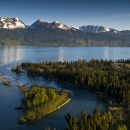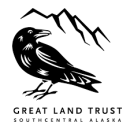The mission of the Alaska Coastal Program is to conserve healthy coastal ecosystems for the benefit of fish, wildlife, and people. As a direct conservation assistance program, the Alaska Coastal Program invests funding, staff time, technical expertise, and other resources into coastal habitat conservation projects in partnership with non-governmental organizations, private landowners, local governments, state agencies and Alaska Native organizations.
In Southcentral Alaska, fish and wildlife are abundant; however, because the region’s human impact is concentrated in coastal areas, habitat degradation of coastal wetlands and estuaries can have a greater negative effect on fish and wildlife resources by degrading key habitats for anadromous fish or migratory birds. Land uses across the region are varied, including community/land development, oil and gas extraction, mining, timber harvest, tourism, recreation, and subsistence activities.
Example Projects
Nic’anilen Na' – Great Land Trust (2021)
An important piece of protected wildlife-rich habitat near the confluence of the Tonsina and Copper Rivers is growing in acreage, thanks to a generous donation by a local couple, and a continued partnership between Great Land Trust and a local science and education nonprofit.
In 2018, a 40-acre property was donated to the Wrangell Institute for Science and Environment (WISE) with a conservation easement conservation easement
A conservation easement is a voluntary legal agreement between a landowner and a government agency or qualified conservation organization that restricts the type and amount of development that may take place on a property in the future. Conservation easements aim to protect habitat for birds, fish and other wildlife by limiting residential, industrial or commercial development. Contracts may prohibit alteration of the natural topography, conversion of native grassland to cropland, drainage of wetland and establishment of game farms. Easement land remains in private ownership.
Learn more about conservation easement held by Great Land Trust. In 2021, 20 acres of land adjacent to the original conserved property were also donated, bringing the total conserved area to 60 acres. This project safeguards habitat and provides a space for WISE to implement its goals of doing research, environmental education, and stewardship. An influx of groundwater at the property creates rare, clear water streams that remain open through winter and encourage rich species diversity. Nic’anilen Na’ is the Ahtna name for this area that translates as “current flows out from shore creek” and describes the stream on the property where it flows into the Copper River.
WISE is a nonprofit organization that has been providing science and environmental education in the Copper River Basin since 2002. Since the original donation in 2018, they have begun to develop a plan for the property, including trails, interpretive signs, and visitor facilities such as outhouses and a pavilion. They hope to ultimately host field trips and camps onsite to share this fascinating and beautiful place with the public. This project was facilitated by Great Land Trust and made possible with funding from the Alaska Sustainable Salmon Fund, the US Fish & Wildlife Service Coastal Program, the generosity of a local couple, and a partnership with WISE.
Deep Creek – Kachemak Heritage Land Trust (2021, 90 acres)
The Kenai Peninsula in Southcentral Alaska is home to spectacular landscapes and abundant fish and wildlife, making it one of the state’s premier travel destinations. Although three quarters of the Kenai Peninsula is protected within three federal management units (Kenai National Wildlife Refuge, Chugach National Forest, and Kenai Fjords National Park), the lower reaches of the most vulnerable anadromous streams and their watersheds flow through unprotected private lands. In 2012, the Kenai Mountains to Sea Partnership was established to seek out voluntary partnerships and proactive conservation measures that leverage existing protections in the headwaters of stream corridors and provide connectivity from “mountains to sea.”
Deep Creek was identified in the Mountains to Sea strategy as a conservation priority and is a State-designated anadromous stream, supporting steelhead, Dolly Varden, and spawning habitats for Pink, Coho, and Chinook salmon. Almost 17 miles of Deep Creek lies within the Kenai National Wildlife Refuge. Outside the refuge boundaries, Deep Creek flows for 34 miles to Cape Ninilchik on the Cook Inlet and is a major recreation destination on the Kenai Peninsula. Working together with the Kachemak Heritage Land Trust, the state of Alaska, and other partners, the Coastal Program conserved 88 acres of coastal wetlands and a half-mile of streambank frontage. This property is of strategic importance not only as a Mountains to Sea Initiative priority but also because it is the site of a fish weir managed by the Alaska Department of Fish and Game. This project represents an important partnership with the state of Alaska, as Alaska Department of Fish and Game had long been interested in acquiring this property to improve their ability to monitor salmon escapement and obtain valuable biological data to better manage the fishery in perpetuity. Due to the desirable location of this property, it was at risk of being developed for small house lots. Through the collaboration of many dedicated partners, this property will now be owned by the Alaska Department of Natural Resources, managed by Alaska Department of Fish and Game, and is protected through an easement through the Bureau of Land management.
Portage Pass – The Conservation Fund (2021)
The Coastal Program works with a wide range of partners to permanently protect natural places important to communities of wildlife and people. In 2021, the Coastal Program assisted The Conservation Fund to protect more than 250 acres of wetland, forest, and river habitat along the Portage Pass, in Southcentral Alaska. Located in Chugach National Forest, Portage Pass provides a shortcut for bears, moose, migratory birds, and other wildlife moving between Prince William Sound and Cook Inlet. The protected land conserves a stream that supports Pacific salmon and other fish as well as preserves a variety of recreation, including hiking on the Portage Pass Trail - a small part of the more than 1,000-mile Iditarod National Historic Trail. The protected land was later transferred to the U.S. Forest Service






